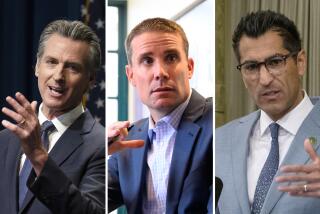Legislators Have Secret Formula for Ticklish Bills
SACRAMENTO — Midway through a hearing on two controversial bills that he sensed were too ticklish to decide in public, Assemblyman Tom Bates, chairman of the Assembly Human Services Committee, did what he thought made sense: He convened five committee members in his private office and banged out a deal.
Then the lawmakers returned to the hearing room. They amended one of the bills and shelved the other for the year, casting their scripted votes without discussion.
To those awaiting the committee’s action, the procedure seemed unusual. But Bates, a Democrat from Oakland, and Assembly Speaker Willie Brown (D-San Francisco) said Thursday that the closed-door session was a typical tactic used often by members of both major parties to decide their strategy on controversial issues.
The Legislature’s attorney has ruled that state law allows lawmakers to meet in secret. But critics of the practice say legislators are elected by the public to conduct the public’s business in the open, not in a private room where their deliberations and decisions are shielded from the light of day.
In this case, the Human Services Committee on Wednesday was considering two bills designed to keep communities from being overburdened by halfway houses, board and care homes, and treatment centers for the mentally ill, drug addicts and alcoholics.
The bills needed five votes for passage, but only four members of the committee were present for the public hearing. After taking testimony, Bates recessed the hearing and reconvened in his office, where a fifth member joined them.
“It was pretty controversial,” Bates said of the bills. “Everybody was trying to posture themselves. It was much better to say, ‘OK, how in the hell are we going to deal with this problem in a logical way.’ ”
Bates said the members of many Assembly committees, especially the powerful Ways and Means Committee, often meet privately to decide what to do publicly. Speaker Brown described these closed meetings as “strategy sessions.”
“With regularity, I meet with . . . collections of committee members, and I never check to see whether or not there are more than a majority or less than a majority,” Brown said.
Walter Zelman, director of California Common Cause, a government watchdog group, said he recognizes that “many deals are cut in closed session” and then ratified in a public meeting.
“But that doesn’t mean it is not important to maintain the appearance, and, to the greatest extent possible, the reality that public decisions are made in public,” Zelman said.
And Mel Opotowsky, president of the California First Amendment Coalition, said he believes the meetings violate the spirit of the state Constitution, which states that all sessions of the Legislature and its committees “shall be public” except as provided in a statute or a resolution approved by two-thirds of the members.
“They’re a public agency,” said Opotowsky, senior managing editor of the Press-Enterprise, a Riverside County newspaper. “It may be inconvenient, or it may be embarrassing, but these are not constitutional reasons for not following the constitutional guidelines.”
The Senate adopted new, stricter standards requiring more open meetings earlier this year after the Legislature came under fire for closed-door sessions at which lawmakers allocated themselves more than $1 million in personal benefits. Local governments have long been required to hold their meetings in public. But Brown said Assembly members are “adult enough” to decide for themselves when to meet in public or private.
Despite Bates’ description of his committee’s action, Brown insisted Thursday that all of the Assembly’s decisions are made in public.
“The law requires you . . . to take your votes in public,” he said. “We take testimony and then we debate the issues and then we vote on the bills as we are required to do under the public glare.”
More to Read
Get the L.A. Times Politics newsletter
Deeply reported insights into legislation, politics and policy from Sacramento, Washington and beyond. In your inbox three times per week.
You may occasionally receive promotional content from the Los Angeles Times.










